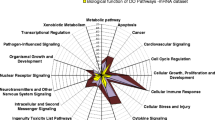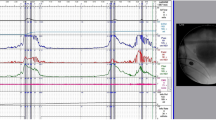Abstract
Purpose
Dysfunctional voiding (DV) in women is a common disorder that causes bladder outlet obstruction (BOO) and may aggravate overactive bladder (OAB) symptoms. The diagnosis of DV relies on clinical alertness and videourodynamic study (VUDS). In this pilot study, we aimed to explore the diagnostic potential of urinary biomarkers in women with DV.
Methods
Women who visited our institute for the management of OAB were enrolled in this prospective study. Urine samples were collected before treatment and urinary proteins were quantified using enzyme-linked immunosorbent assay (ELISA) kits. Patients with DV and patients with normal tracings were included in the study and control group, respectively. The patients with DV were further divided into two subgroups: those with and those without detrusor overactivity (DO). VUDS parameters and urinary protein levels were compared between each subgroup.
Results
A total of 67 women were enrolled. There were 47 patients with VUDS-diagnosed DV and 20 patients in the control group. Urinary 8-OHdG level (32.65 vs. 15.59, p < 0.001) and urinary TNF-α level (1.43 vs. 0.83, p = 0.031) were significantly higher in the DV group, and urinary IL-2 level (0.29 vs. 0.83, p < 0.001) was significantly lower in the DV group. Among the DV patients, urinary PGE2 level was higher in the DO group (240.4 vs 149.6, p = 0.049).
Conclusions
In women with DV, urinary 8-OHdG level is elevated compared to women with normal VUDS. Urinary PGE2 level is elevated in patients with DV and DO. These finding suggests increased reactive-oxidative stress response and detrusor hyperactivity in DV patients. Urinary biomarkers can serve as potential non-invasive diagnostic tools in women with OAB.

Similar content being viewed by others
Data availability
All of the data are presented in the manuscript.
References
Abrams P et al (2002) The standardisation of terminology of lower urinary tract function: report from the Standardisation Sub-committee of the International Continence Society. Neurourol Urodyn 21(2):167–178
Liu SP et al (2019) The prevalence and bother of lower urinary tract symptoms in men and women aged 40 years or over in Taiwan. J Formos Med Assoc 118(1 Pt 1):170–178
Nambiar AK et al (2022) European association of urology guidelines on the diagnosis and management of female non-neurogenic lower urinary tract symptoms. Part 1: diagnostics, overactive bladder, stress urinary incontinence, and mixed urinary incontinence. Eur Urol 82(1):49–59
Lightner DJ et al (2019) Diagnosis and treatment of overactive bladder (non-neurogenic) in adults: AUA/SUFU guideline amendment 2019. J Urol 202(3):558–563
Kuo HC (2000) Videourodynamic study for diagnosis of bladder outlet obstruction in women. J Formos Med Assoc 99(5):386–392
Lee CL et al (2022) Effect of videourodynamic subtypes on treatment outcomes of female dysfunctional voiding. Int Urogynecol J 33(5):1283–1291
Kuo HC (2012) Potential biomarkers utilized to define and manage overactive bladder syndrome. Low Urin Tract Symptoms 4(Suppl 1):32–41
Chow PM, Hsiao SM, Kuo HC (2021) Identifying occult bladder outlet obstruction in women with detrusor-underactivity-like urodynamic profiles. Sci Rep 11(1):23242
Wu LL et al (2004) Urinary 8-OHdG: a marker of oxidative stress to DNA and a risk factor for cancer, atherosclerosis and diabetics. Clin Chim Acta 339(1–2):1–9
Loft S et al (1992) Oxidative DNA damage estimated by 8-hydroxydeoxyguanosine excretion in humans: influence of smoking, gender and body mass index. Carcinogenesis 13(12):2241–2247
Martinet W et al (2002) Elevated levels of oxidative DNA damage and DNA repair enzymes in human atherosclerotic plaques. Circulation 106(8):927–932
Holbrook J et al (2019) Tumour necrosis factor signalling in health and disease. F1000Res 8:F1000 Faculty Rev-111
He FF et al (2015) Tumor necrosis factor-alpha and 8-hydroxy-2′-deoxyguanosine are associated with elevated urinary angiopoietin-2 level in type 2 diabetic patients with albuminuria. Kidney Blood Press Res 40(4):355–365
Blaser H et al (2016) TNF and ROS crosstalk in inflammation. Trends Cell Biol 26(4):249–261
Ross SH, Cantrell DA (2018) Signaling and function of interleukin-2 in t lymphocytes. Annu Rev Immunol 36:411–433
Villarino AV et al (2007) Helper T cell IL-2 production is limited by negative feedback and STAT-dependent cytokine signals. J Exp Med 204(1):65–71
Schimpl A et al (2002) IL-2 and autoimmune disease. Cytokine Growth Factor Rev 13(4–5):369–378
Yokoyama O et al (2007) Antimuscarinic drug inhibits detrusor overactivity induced by topical application of prostaglandin E2 to the urethra with a decrease in urethral pressure. J Urol 178(5):2208–2212
Su X et al (2008) An excitatory role for peripheral EP3 receptors in bladder afferent function. Am J Physiol Renal Physiol 295(2):F585–F594
Wheeler MA et al (2002) Prostaglandin E2 production and cyclooxygenase-2 induction in human urinary tract infections and bladder cancer. J Urol 168(4 Pt 1):1568–1573
Kim JC et al (2006) Nerve growth factor and prostaglandins in the urine of female patients with overactive bladder. J Urol 175(5):1773–1776 (discussion 1776)
Nomiya M, Andersson KE, Yamaguchi O (2015) Chronic bladder ischemia and oxidative stress: new pharmacotherapeutic targets for lower urinary tract symptoms. Int J Urol 22(1):40–46
Kaplan WE, Firlit CF, Schoenberg HW (1980) The female urethral syndrome: external sphincter spasm as etiology. J Urol 124(1):48–49
Hinman F Jr (1986) Nonneurogenic neurogenic bladder (the Hinman syndrome)–15 years later. J Urol 136(4):769–777
Chancellor M, Lamb L (2021) Toward a validated diagnostic test with machine learning algorithm for interstitial cystitis. Urol Sci 32(1):2–7
Moledina DG et al (2019) Urine TNF-alpha and IL-9 for clinical diagnosis of acute interstitial nephritis. JCI Insight 4(10):e127456
Funding
No funding was received to assist with the preparation of this manuscript.
Author information
Authors and Affiliations
Contributions
PMC: manuscript writing, data management, data analysis. HCK: project development.
Corresponding author
Ethics declarations
Conflict of interest
The authors have no competing interests to declare that are relevant to the content of this article.
Consent to participate
Informed consents were obtained from all individual participants included in the study.
Ethics approval
All procedures performed in studies involving human participants were in accordance with the ethical standards of the institutional and/or national research committee and with the 1964 Helsinki Declaration and its later amendments or comparable ethical standards. The study was approved by the Institutional Review Board of the Buddhist Tzu Chi University (TCGH IRB: 107-37-A).
Additional information
Publisher's Note
Springer Nature remains neutral with regard to jurisdictional claims in published maps and institutional affiliations.
Rights and permissions
About this article
Cite this article
Chow, PM., Kuo, HC. Performance of urinary biomarkers in differentiating dysfunctional voiding in women with overactive bladder syndrome: a prospective pilot study. Int Urol Nephrol 54, 2497–2502 (2022). https://doi.org/10.1007/s11255-022-03265-7
Received:
Accepted:
Published:
Issue Date:
DOI: https://doi.org/10.1007/s11255-022-03265-7




